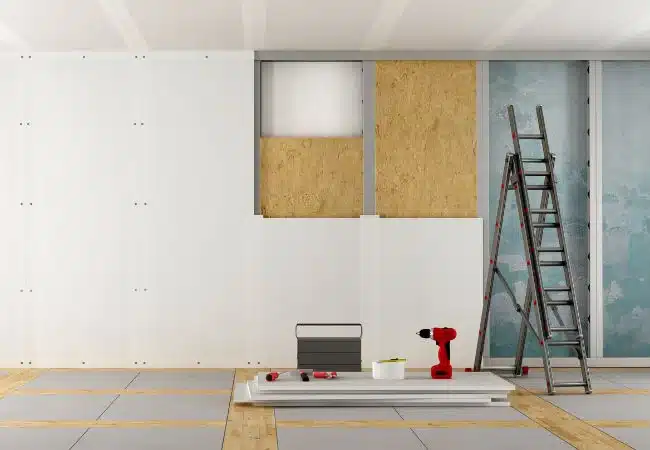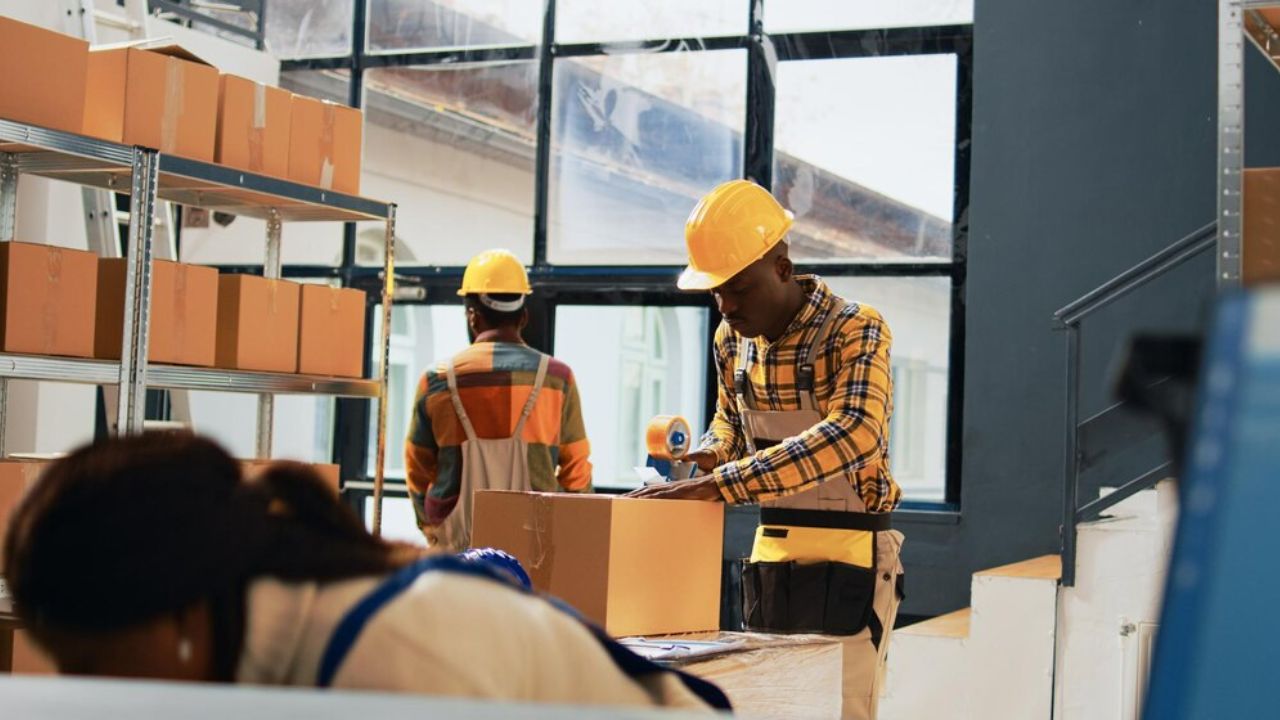Walls, the defining elements of interior spaces, serve as structural and aesthetic components, providing stability, privacy, and a canvas for personal expression.
Their construction, a fundamental aspect of architecture and interior design, has evolved over centuries, reflecting advancements in materials, techniques, and design philosophies.
Drywall and plaster are among the most common and versatile wall finishing materials, each with distinct characteristics and applications.
In this article, we have revealed the significant Difference Between Drywall and Plaster. Carefully read through.
Table of contents
Brief Historical Context of Drywall and Plaster
Drywall, also known as gypsum board, emerged in the early 20th century as a lightweight and efficient alternative to traditional plaster walls.
Its composition of gypsum sandwiched between layers of paper offered ease of installation and reduced construction time, making it a popular choice for residential and commercial projects.
Conversely, Plaster has a long and rich history, dating back to ancient civilizations. Its versatility and ability to create smooth, intricate finishes have made it a favored material for centuries, adorning the walls of palaces, cathedrals, and homes.
Purpose and Scope of the Comparison
By understanding each material’s unique properties and advantages, architects, interior designers, and homeowners can make informed decisions that align with their project requirements and aesthetic preferences. The comparison will cover aspects such as
- Material composition and properties
- Installation methods and requirements
- Durability and maintenance considerations,
- Aesthetic versatility and design possibilities
- Cost-effectiveness and economic factors
- Environmental impact and sustainability considerations.
Read ALSO: How to Change Background Color on Instagram Story: Vibrant Customization Secrets
Composition and Construction: Drywall vs. Plaster
Drywall
Drywall, also known as gypsum board or sheetrock, is a versatile and widely used wall construction material composed of three primary components:
- Gypsum Board: The heart of drywall is gypsum, a mineral-based compound derived from calcium sulfate dihydrate. This naturally occurring substance provides drywall with its fire-resistant and soundproofing properties.
- Paper Facings: Gypsum is sandwiched between two layers of heavy paper, typically made from recycled paper products. These paper facings provide structural reinforcement and a smooth surface for painting or finishing.
- Additives: Various additives, such as starch, cellulose fibers, and fiberglass, are incorporated into the gypsum core to enhance its strength, flexibility, and moisture resistance.
Construction: Drywall installation is a relatively straightforward process, typically involving the following steps:
- Framing: A framework of metal or wooden studs is erected to define the wall’s shape and support the drywall panels.
- Hanging Drywall Panels: Drywall panels are cut to size and attached to the studs using screws or nails. Joints between panels are then taped, mudded, and sanded to create a smooth, seamless surface.
- Finishing: Once the drywall is installed and joints are finished, the surface is ready for painting, wallpapering, or other decorative finishes.
Plaster
Plaster, an ancient building material, is renowned for its durability, versatility, and ability to create intricate, decorative surfaces. Its composition varies depending on the desired properties and application but typically includes the following components:
- Traditional Plaster Components:
a. Binder: Plaster typically utilizes a binder, such as lime, gypsum, or cement, to bind the aggregate and provide strength and cohesion.
b. Aggregate: An aggregate, such as sand or crushed stone, is added to the binder to increase the Plaster’s bulk and provide a textured surface.
c. Water: Water is essential for the hydration of the binder, allowing it to set and harden.
- Methods of Application:
Plaster application techniques have evolved, but the fundamental methods remain unchanged:
a. Wet Plaster Method: In this traditional method, wet plaster is mixed and applied directly to the wall surface using trowels or hands. This method allows for sculpting and shaping the application to create intricate designs.
b. Dry Plaster Method: This method involves prefabricating plaster panels in a controlled environment and then attaching them to the wall using adhesives or mechanical fasteners. Dry plaster panels offer greater consistency and less drying time than wet plaster.
Read ALSO: How Many Stamps in a Book: Postage Planning Knowledge
Installation: Drywall vs. Plaster
Drywall installation is a relatively straightforward process that can be completed with proper tools and techniques. Here’s a breakdown of the key steps involved:
1. Preparing for Drywall Installation
a. Layout and Marking: Measure and mark the wall studs to determine the placement of drywall panels. This ensures proper alignment and a smooth, finished surface.
b. Cutting Drywall Panels: Cut the drywall panels to the desired dimensions using a utility knife or drywall saw. Ensure accurate measurements to avoid unnecessary gaps or overlaps.
c. Raising and Positioning Drywall Panels: Carefully lift and position the drywall panels onto the wall studs, aligning them according to the markings.
2. Techniques for Hanging Drywall Sheets
- Screwing or Nailing: Secure the drywall panels to the studs using screws or nails specifically designed for drywall installation. Ensure the fasteners are driven into the studs at appropriate intervals.
- Joint Taping and Mudding: After hanging the drywall panels, apply joint tape and mud to the seams between the boards. This creates a seamless, smooth surface for finishing.
- Sanding: Once the joint compound has dried, sand the surface to remove imperfections and create a uniform finish.
3. Finishing and Sanding
a. Prime Coating: Apply a primer to the entire drywall surface to enhance paint adhesion and ensure even color coverage.
b. Painting or Texturing: Apply the desired paint or texture to the drywall surface once the primer is dry. Choose a color or texture that complements the overall décor of the space.
Strength and Durability: Drywall vs. Plaster
Drywall and Plaster differ significantly in their structural integrity and durability.
Drywall is susceptible to moisture damage, and prolonged exposure to water can lead to warping, mold growth, and structural compromise. While drywall can be repaired, replacement may be necessary in severe cases.
Plaster, on the other hand, is more resistant to moisture and impact damage. Its strength and durability make it well-suited for high-traffic areas and applications where structural integrity is crucial.
However, Plaster can crack or develop hairline fractures over time due to settling and temperature fluctuations.
Drywall vs Plaster Cost
The material costs of drywall and Plaster vary significantly. Drywall is generally less expensive than Plaster, ranging from $3 to $5 per square foot.
Plaster, on the other hand, can cost anywhere from $10 to $50 per square foot, depending on the type of Plaster used, the complexity of the application, and the desired finish.
Cost-Effective Applications for Different Spaces
Drywall is often the most cost-effective for large, non-public areas such as bedrooms, hallways, and living rooms. Its ease of installation and lower material costs make it a practical solution for these spaces.
Plaster is often preferred for high-traffic areas such as kitchens, bathrooms, and entryways due to its durability and resistance to moisture damage. It is also a popular choice for heritage buildings and spaces where a more traditional or artistic aesthetic is desired.
Read ALSO: How to Use a Ratchet Strap: Secure Fastening Technique
Labor and Installation Costs
1. Labor Expenses for Installation
Labor costs for drywall and plaster installation also differ. Drywall installation is generally less labor-intensive, with labor costs typically ranging from $1 to $3 per square foot. Plaster installation, on the other hand, requires specialized skills and techniques, resulting in higher labor costs of $5 to $20 per square foot.
2. Time and Labor-Intensiveness of Application
Drywall installation can be completed relatively quickly, often within a few days for typical-sized rooms. Plaster installation, however, is more time-consuming, typically taking several days or weeks, depending on the project size and complexity.
Drywall vs Plaster Repairs
Drywall is susceptible to various types of damage, including:
- Holes and Punctures: To create a smooth, seamless surface, these can be repaired using drywall patches, joint compounds, and sanding.
- Cracks and Gaps: Cracks can be filled with joint compound and sanded, while gaps between panels can be sealed with caulking or sealant.
- Water Damage: Warped or damaged drywall due to moisture exposure may require replacement of the affected panels.
Plaster, while durable, can also experience damage:
- Cracks and Hairline Fractures: Fine cracks are common in older plaster surfaces and can be repaired with a hairline crack filler.
- Larger Cracks and Holes: Larger cracks may require plaster patching, sanding, and finishing.
- Moisture Damage: Plaster can be more moisture-resistant than drywall, but prolonged exposure can lead to cracking and deterioration. Repairing damaged Plaster requires careful assessment and specialized techniques.
Routine Maintenance Requirements
Regular maintenance for drywall includes:
- Inspecting for damage: Regularly check for signs of wear, such as holes, cracks, or water stains.
- Moisture control: Maintain proper ventilation to prevent moisture buildup, which can lead to mold growth and drywall damage.
- Touch-ups: Address minor repairs promptly to prevent further deterioration.
Plaster maintenance involves:
- Cleaning: Regularly clean plaster surfaces with a damp cloth or mild detergent solution. Avoid harsh abrasives or chemicals.
- Moisture control: Maintain proper ventilation and promptly address leaks or moisture issues to prevent water damage.
- Repainting or refinishing: Repaint or refinish plaster surfaces periodically to maintain their appearance and protect them from deterioration.
In summary, drywall requires regular inspections and prompt repairs to maintain its integrity. Plaster, while more durable, benefits from regular cleaning, moisture control, and periodic refinishing to preserve its aesthetic appeal and longevity.
Read Also: How to Make an Iron Golem in Minecraft: Ultimate Crafting Guide for Robust Defenders
FAQs
Drywall and Plaster are common materials used for interior walls. Still, they have several key differences:
Material composition: Drywall is made of gypsum, a mineral-based compound sandwiched between paper facings. Plaster is typically a mixture of lime, gypsum, or cement combined with sand or crushed stone aggregate.
Installation: Drywall installation is straightforward, involving hanging panels on studs and finishing the seams. Plaster application is more complex, requiring specialized skills and techniques.
Aesthetics: Drywall provides a smooth, flat surface suitable for various finishes, including paint, wallpaper, and texture. Plaster offers greater versatility in texture and finish, allowing for sculpting, molding, and intricate designs.
Durability: Plaster is generally more durable than drywall and less susceptible to impact damage and moisture penetration. However, drywall is more lightweight and flexible, making it less prone to cracking due to settling or temperature fluctuations.
Cost: Drywall is typically less expensive than Plaster regarding material costs and labor requirements.
Both drywall and Plaster provide some sound insulation, but Plaster generally offers slightly better soundproofing due to its higher density and solid structure. However, both materials can be combined with soundproofing insulation batts or panels to enhance soundproofing performance further.
Yes, Plaster is generally more durable than drywall in terms of resistance to impact damage, moisture penetration, and fire resistance. Plaster’s density and solid structure make it less prone to dents, holes, and moisture-related damage. Additionally, Plaster’s non-combustible nature provides better fire resistance compared to drywall.
Yes, both drywall and plaster surfaces can be painted. However, proper surface preparation is essential for optimal paint adhesion and a durable finish. For drywall, ensure the surface is clean, dry, and free from imperfections before painting. Depending on its condition, Plaster may require additional preparation, such as patching cracks or primer.
Conclusion
Understanding the differences between drywall and Plaster is crucial for anyone involved in construction or renovation projects. While both materials serve the same purpose of creating smooth, durable walls and ceilings, their composition and application methods vary significantly.
Drywall offers quicker installation and more straightforward repairs, making it a popular choice for modern construction.
On the other hand, Plaster provides a timeless aesthetic and superior soundproofing properties. Ultimately, deciding between drywall and plaster depends on individual project requirements, budget constraints, and aesthetic preferences.
References
Recommendations
- How to Change Background Color on Instagram Story: Vibrant Customization Secrets
- How Many Stamps in a Book: Postage Planning Knowledge
- How to Shuffle Cards: Card Game Dexterity
- How to Make an Iron Golem in Minecraft: Ultimate Crafting Guide for Robust Defenders
- How to Use a Ratchet Strap: Secure Fastening Technique






